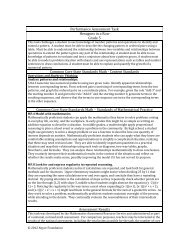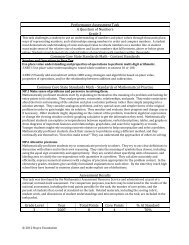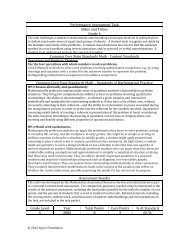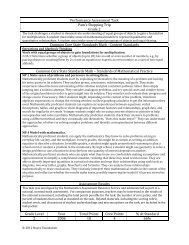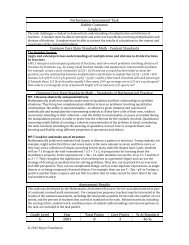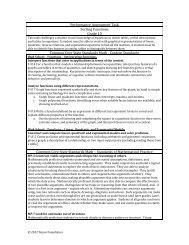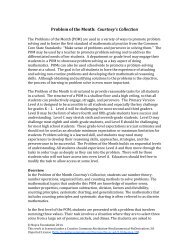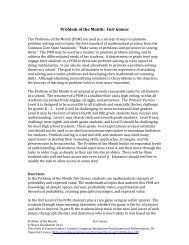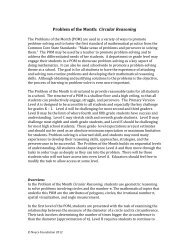Truffles - Inside Mathematics
Truffles - Inside Mathematics
Truffles - Inside Mathematics
Create successful ePaper yourself
Turn your PDF publications into a flip-book with our unique Google optimized e-Paper software.
Performance Assessment Task<br />
<strong>Truffles</strong><br />
Grade 6<br />
The task challenges a student to demonstrate understanding of ratios and proportions. A student<br />
must be able to model and solve contextualized problems using various representations, such as<br />
graphs, tables, and equations. A student must make sense of and interpret line graphs. A student<br />
must determine a generalized rule from an understanding of ratio and proportional reasoning in a<br />
given real‐world context.<br />
Common Core State Standards Math ‐ Content Standards<br />
Ratios and Proportional Relationships<br />
Understand ratio concepts and use ratio reasoning to solve problems.<br />
6.RP.1 Understand the concept of a ratio and use ratio language to describe a ratio relationship<br />
between two quantities. For example, “The ratio of wings to beaks in the bird house at the zoo was 2:1,<br />
because for every 2 wings there was 1 beak.” “For every vote candidate A received, candidate C received<br />
nearly three votes.”<br />
6.RP.2 Understand the concept of a unit rate a/b associated with a ratio a:b with b = 0, and use rate<br />
language in the context of a ratio relationship. For example, “This recipe has a ratio of 3 cups of flour to<br />
4 cups of sugar, so there is 3/4 cup of flour for each cup of sugar.” “We paid $75 for 15 hamburgers,<br />
which is a rate of $5 per hamburger.”<br />
Expressions and Equations<br />
Represent and analyze quantitative relationships between dependent and independent<br />
variables.<br />
6.EE.9 Use variables to represent two quantities in a real‐world problem that change in relationship<br />
to one another; write an equation to express one quantity, thought of as the dependent variable, in<br />
terms of the other quantity, thought of as the independent variable. Analyze the relationship between<br />
the dependent and independent variables using graphs and tables, and relate these to the equation.<br />
For example, in a problem involving motion at constant speed, list and graph ordered pairs of distances<br />
and times, and write the equation d = 65t to represent the relationship between distance and time.<br />
Common Core State Standards Math – Standards of Mathematical Practice<br />
MP.6 Attend to precision.<br />
Mathematically proficient students try to communicate precisely to others. They try to use clear<br />
definitions in discussion with others and in their own reasoning. They state the meaning of the<br />
symbols they choose, including using the equal sign consistently and appropriately. They are careful<br />
about specifying units of measure, and labeling axes to clarify the correspondence with quantities in<br />
a problem. They calculate accurately and efficiently, express numerical answers with a degree of<br />
precision appropriate for the problem context. In the elementary grades, students give carefully<br />
formulated explanations to each other. By the time they reach high school they have learned to<br />
examine claims and make explicit use of definitions.<br />
MP.8 Look for and express regularity in repeated reasoning.<br />
Mathematically proficient students notice if calculations are repeated, and look both for general<br />
methods and for shortcuts. Upper elementary students might notice when dividing 25 by 11 that they<br />
are repeating the same calculations over and over again, and conclude they have a repeating decimal.<br />
By paying attention to the calculation of slope as they repeatedly check whether points are on the<br />
line through (1, 2) with slope 3, middle school students might abstract the equation (y – 2)/(x – 1) =<br />
3. Noticing the regularity in the way terms cancel when expanding (x–1)(x+1), (x–1)(x2+x+1), and<br />
(x–1)(x3 +x2+x+1) might lead them to the general formula for the sum of a geometric series. As they<br />
work to solve a problem, mathematically proficient students maintain oversight of the process, while<br />
attending to the details. They continually evaluate the reasonableness of their intermediate results.<br />
Assessment Results<br />
This task was developed by the <strong>Mathematics</strong> Assessment Resource Service and administered as part<br />
of a national, normed math assessment. For comparison purposes, teachers may be interested in the<br />
© 2012 Noyce Foundation
esults of the national assessment, including the total points possible for the task, the number of core<br />
points, and the percent of students that scored at standard on the task. Related materials, including<br />
the scoring rubric, student work, and discussions of student understandings and misconceptions on<br />
the task, are included in the task packet.<br />
Grade Level Year Total Points Core Points % At Standard<br />
6 2009 9 5 68 %<br />
© 2012 Noyce Foundation
<strong>Truffles</strong><br />
This problem gives you the chance to:<br />
• do calculations in a real situation<br />
Linda makes chocolate truffles.<br />
The recipe for 20 dark chocolate truffles is<br />
1 cup cream<br />
2 cups dark chocolate<br />
1. Complete the recipe for 40 dark truffles<br />
_________ cups cream<br />
_________ cups dark chocolate<br />
2. One day, Linda has 8 cups of dark chocolate and plenty of cream.<br />
How many truffles can she make?<br />
Explain how you figured it out.<br />
____________<br />
__________________________________________________________________<br />
__________________________________________________________________<br />
3. The recipe for Super <strong>Truffles</strong> is different. The graph on the next page shows how much<br />
cream and<br />
chocolate to use.<br />
How much chocolate does Linda need for two cups of cream?<br />
4. How much cream does she need for 15 cups of chocolate?<br />
_____________________<br />
_____________________<br />
Grade 6<br />
Copyright © 2009 by <strong>Mathematics</strong> Assessment<br />
Resource Service. All rights reserved.<br />
23
Super <strong>Truffles</strong><br />
20<br />
19<br />
18<br />
17<br />
16<br />
15<br />
14<br />
13<br />
12<br />
Number of cups<br />
of chocolate<br />
11<br />
10<br />
9<br />
8<br />
7<br />
6<br />
5<br />
4<br />
3<br />
2<br />
1<br />
0<br />
0 1 2 3 4 5 6 7 8<br />
Number of cups of cream<br />
5. Write a rule that Linda can use to figure out how many cups of chocolate she needs for any<br />
number of cups of cream when making Super <strong>Truffles</strong>.<br />
__________________________________________________________________________<br />
__________________________________________________________________________<br />
Grade 6<br />
Copyright © 2009 by <strong>Mathematics</strong> Assessment<br />
Resource Service. All rights reserved.<br />
24<br />
9
<strong>Truffles</strong><br />
•<br />
• The core elements of performance required by this task are:<br />
• • do calculations in a real situation<br />
•<br />
Based on these, credit for specific aspects of performance should be assigned as follows<br />
Rubric<br />
points<br />
section<br />
points<br />
1. Gives correct answers: 2<br />
2. Gives correct answer: 80<br />
Gives correct explanation such as:<br />
She can make four times as many as the recipe.<br />
4<br />
3 Gives correct answer: 5 cups 1<br />
4. Gives correct answer: 6 cups 1<br />
5. Gives correct rule such as:<br />
Multiply the number of cups of cream by two and a half.<br />
Partial credit<br />
Shows a 2.5: 1 ratio or equivalent.<br />
1<br />
1 2<br />
(1)<br />
2<br />
Total Points 9<br />
1<br />
2<br />
2<br />
3<br />
1<br />
1<br />
Grade 6<br />
Copyright © 2009 by <strong>Mathematics</strong> Assessment<br />
Resource Service. All rights reserved.<br />
25
<strong>Truffles</strong><br />
Work the task and look at the rubric. What are the big mathematical ideas a student<br />
needs to understand to be successful on this task?_____________________________<br />
Look at student work for part 2, finding the amount of truffles for a given amount of<br />
chocolate. How many of your students put:<br />
80 160 60 4 40 Other<br />
How might students have gotten an answer of 160? 60? 4? How are these<br />
misconceptions different?<br />
Look at student work of part 3, finding the amount of chocolate for 2 cups of cream using<br />
the graph. How many of your students:<br />
• Could read the graph and find the answer of 5 cups?_____________<br />
• Used the old formula and put 4 cups?_________<br />
• Put 1 cup?_________ What might they be thinking?<br />
Now look at reading the graph from the vertical scale to the horizontal scale. How many<br />
of your students put:<br />
6 14 5 7 1/2 3 Other<br />
What was problematic for students? What didn’t they understand about the situation?<br />
Now look at the rules for finding chocolate for Super <strong>Truffles</strong>. How many of your<br />
students could:<br />
• Write a multiplication rule, chocolate is 2.5 times the amount of cream?________<br />
• Write the ratio: 2.5 chocolates for every cream?_______<br />
• Describe how to use the graph to find the answer?_________<br />
• Make a table and told how to use it?___________<br />
• Gave a rule about odd and even?________<br />
• Gave a recursive rule, like add two or add five?__________<br />
• Made a rule that wouldn’t work for all the examples?<br />
• Did not attempt a rule?___________<br />
What do you think students understand about writing a rule?<br />
How often do students in your class get an opportunity to make generalizations or write<br />
rules using algebra? How can you plan a class discussion to help students make more<br />
sense of this idea of writing a rule? How do students learn to check rules against the<br />
evidence? What do we want sixth graders to understand about slope, growth, and<br />
algebraic or number sentence notation? What is the foundation at this grade level for later<br />
algebraic thinking?<br />
Grade 6<br />
Copyright © 2009 by Noyce Foundation<br />
All rights reserved.<br />
26
Looking at Student Work on <strong>Truffles</strong><br />
Student A looks for a multiplicative relationship to find the number of truffles in part 2.<br />
The student can then apply this strategy to finding a rule in part 5. Notice how the rule is<br />
different than stating a ratio.<br />
Student A<br />
Grade 6<br />
Copyright © 2009 by Noyce Foundation<br />
All rights reserved.<br />
27
Student B is able to identify and extend a pattern to chug out an answer in part 2. In part<br />
5, the student should have been given no marks. The student has used the graph to make<br />
a table. The student doesn’t correctly quantify how the pattern is growing at the top of<br />
the table and doesn’t identify a ratio of 2.5 to 1. What questions might push this student<br />
to look more closely for a relationship?<br />
Student B<br />
Grade 6<br />
Copyright © 2009 by Noyce Foundation<br />
All rights reserved.<br />
28
Student B, part 2<br />
Grade 6<br />
Copyright © 2009 by Noyce Foundation<br />
All rights reserved.<br />
29
Student C seems to understand the mathematics of the task but is unclear about how to<br />
develop a mathematical explanation in part 2. What types of classroom activities help<br />
students develop the logic of making an explanation? How can you use models to help<br />
students see what constitutes a good explanation? The student uses a ratio in part 5.<br />
Student C<br />
Grade 6<br />
Copyright © 2009 by Noyce Foundation<br />
All rights reserved.<br />
30
Look at the work of student D on part 2. Where does the 3 come from? What is the<br />
misconception or faulty logic of this argument? In part 3 the student is able to obtain a<br />
correct solution, but look at the misconception about dividing with decimals. How does<br />
this prevent the student from seeing and quantifying a relationship in part 5?<br />
Student D<br />
Grade 6<br />
Copyright © 2009 by Noyce Foundation<br />
All rights reserved.<br />
31
Student E cannot make sense of the idea that there is plenty of cream in part 2. The<br />
student does not understand the qualities of a rule for this grade level. While at earlier<br />
grades noticing that the pattern is about odd and even is acceptable, at this grade level<br />
students need to look for ways of quantifying relationships. What types of experiences<br />
does this student need?<br />
Student E<br />
Grade 6<br />
Copyright © 2009 by Noyce Foundation<br />
All rights reserved.<br />
32
Student F identifies points on the graph to correctly solve part 3 and 4. However the<br />
student doesn’t use that information when making the table. In part 2 the student made a<br />
table increasing by 20 each time. Here the student uses a recursive rule of adding 2.<br />
What is an expression that would quantify the relationship shown in the table? What<br />
evidence should the student have noticed that would hint this rule is incorrect?<br />
Student F<br />
Grade 6<br />
Copyright © 2009 by Noyce Foundation<br />
All rights reserved.<br />
33
Student G, H, and I all thought the number of truffles in part two was 160. What was the<br />
thinking or logic of their strategy? Why doesn’t it work? Where does it break down<br />
mathematically?<br />
Student G<br />
Student H<br />
Student I<br />
Grade 6<br />
Copyright © 2009 by Noyce Foundation<br />
All rights reserved.<br />
34
Student I is also confused about how to use a scale on the graph. The student doesn’t<br />
understand how to read points that aren’t on grid lines.<br />
Student I<br />
Grade 6<br />
Copyright © 2009 by Noyce Foundation<br />
All rights reserved.<br />
35
Look at the explanation of Student J. What is the underlying mathematics that allows this<br />
strategy to work? How is it different from some of the strategies of the previous 3<br />
students? In part 5 the Student J talks about adding 1/2, but the rule is multiplicative. Why<br />
does this work mathematically? What types of experiences may have helped the student<br />
to do this kind of reasoning?<br />
Student J<br />
Grade 6<br />
Copyright © 2009 by Noyce Foundation<br />
All rights reserved.<br />
36
Student K has trouble with picking operations in part 2. The student solves for the<br />
amount of cream needed instead of the number of truffles. In part 3 the student uses the<br />
graph correctly but puts a different answer on the line. How might the student have<br />
gotten an answer of 1 in part 4? In part 5 the student attempts to write a rule, but gives a<br />
rule with no operation. How do we help students develop a deeper understanding of<br />
operation at this grade level? How do we make this understanding more explicit?<br />
Student K<br />
Grade 6<br />
Copyright © 2009 by Noyce Foundation<br />
All rights reserved.<br />
37
6 th Grade Task 2 <strong>Truffles</strong><br />
Student Task<br />
Core Idea 3<br />
Algebra and<br />
Functions<br />
Core Idea 1<br />
Number and<br />
Operation<br />
Do calculations involving rates a real situation.<br />
Understand relations and functions, analyze mathematical<br />
situations, and use models to solve problems involving quantity and<br />
change.<br />
• Represent analyze, and generalize a variety of relations and<br />
functions with tables, graphs and words.<br />
• Represent probabilities as ratios, proportions, decimals or<br />
percents.<br />
• Model and solve contextualized problems using various<br />
representations, such as graphs tables, and equations.<br />
• Understand and use proportional reasoning to represent<br />
quantitative relationships.<br />
<strong>Mathematics</strong> of the task:<br />
• Understanding ratios and multiplicative relationships<br />
• Identifying and extending a pattern<br />
• Reading and interpreting a graph<br />
• Understanding scale<br />
• Using data from a graph or looking at slope to find a rule<br />
• Writing a rule for a multiplicative relationship from the ratio<br />
Based on teacher observations, this is what sixth graders know and are able to do:<br />
• Complete the recipe for 40 truffles<br />
• Read the graph to find the amount of cream and chocolate for Super <strong>Truffles</strong><br />
Areas of difficulty for sixth graders:<br />
• Using multiplication to find the truffles in part 2<br />
• Explaining their thinking mathematically in part 2<br />
• Finding the ratio of cream to chocolate in part 5<br />
• Writing a rule for finding the chocolate for any amount of cream in part 5<br />
Strategies used by successful students:<br />
• Students who used multiplication in part two were more likely to find a rule or<br />
ratio in part 5<br />
Grade 6<br />
Copyright © 2009 by Noyce Foundation<br />
All rights reserved.<br />
38
The maximum score available for this task is 9 points.<br />
The minimum score needed for a level 3 response, meeting standard, is 5 points.<br />
Most students, 93%, could find the recipe for making 40 truffles. Many students, 75%,<br />
could find the recipe for 40 truffles and read the graph to find the amount of chocolate<br />
and cream in part 3 and 4. More than half the students, 63%, could also find the amount<br />
of truffles in part 2. Almost half the students, 44%, could explain how to find the number<br />
of truffles in part 2. A few students, 17%, could identify the ratio of cream to chocolate<br />
for Super <strong>Truffles</strong>. Almost 9% could meet all the demands of the task including writing a<br />
rule for finding chocolate for any amount of cream. About 5% of the students scored no<br />
points on this task. All the students in the sample with this score attempted the task.<br />
Grade 6<br />
Copyright © 2009 by Noyce Foundation<br />
All rights reserved.<br />
39
<strong>Truffles</strong><br />
Points Understandings Misunderstandings<br />
0 All the students in the sample<br />
with this score attempted the<br />
Students struggled with extending the<br />
recipe from 20 to 40 truffles.<br />
task.<br />
2 Students could double a recipe. Students had difficulty reading the graph.<br />
9% of the students thought there were 4<br />
cups of chocolate in part 3. 4% thought<br />
there would be 1 cup of chocolate. In part 3<br />
4% thought there were be 14 cups of<br />
cream, 4% thought there would be 5 cups<br />
of cream, and 3% thought there would be 7<br />
4 Students could extend the recipe<br />
to 40 truffles and use the graph to<br />
find the amount of chocolate or<br />
cream.<br />
5 Students could extend the recipe<br />
to 40 truffles, find the number of<br />
truffles in part 2, and read the<br />
graph.<br />
7 Students could also explain how<br />
to find the number of truffles in<br />
part 2.<br />
1/2 cups of cream.<br />
Students struggled with finding the amount<br />
of truffles that could be made with 8 cups<br />
of chocolate in part 2. 8% thought there<br />
would be 160 truffles. 7% thought there<br />
could be 60 truffles. 4% thought there were<br />
be only 4 truffles.<br />
Students struggled with explaining how to<br />
find the number of truffles.<br />
Students struggled with finding<br />
relationships from the graph in part 5. 18%<br />
wrote descriptions of how to use the graph.<br />
Many students gave recursive rules like<br />
add 5 every time or made a table. 6% did<br />
not attempt to write a rule.<br />
8 15% of the students gave a ratio, but<br />
couldn’t use that ratio to write a<br />
multiplicative rule.<br />
9 Students could work with ratios<br />
to extend a recipe, read and<br />
interpret a graph, and use the<br />
ratio to write a multiplicative rule<br />
to find the chocolate for any<br />
amount of cream.<br />
Grade 6<br />
Copyright © 2009 by Noyce Foundation<br />
All rights reserved.<br />
40
Implications for Instruction<br />
Students need to be able to work with simple ratios, such as 1:2 and be able to extend<br />
them to double or triple a recipe. Students need to be able to reason about patterns<br />
requiring multiple steps. In this case students needed to think about a recipe for 20<br />
chocolates and extend the recipe for 40 chocolates. Students should be exposed to tools<br />
for thinking about ratios, such as graphing and ratio tables. Students also needed to think<br />
that if the recipe requiring 2 cups of chocolate was increased to 8 cups of chocolate, how<br />
many truffles could be made. In other words, students should be able to convert between<br />
equal ratios.<br />
In learning about ratios, students should also be comfortable with changing the ratios to<br />
rules. This should start with students recognizing the importance of unit ratios and then<br />
converting the unit ratio into a rule. Having students solve a variety of problems<br />
involving ratios in context helps students to see the purpose for being able to find and use<br />
a rule.<br />
Ideas for Action Research: Rate Palooza<br />
Using a Problem of the Month is a powerful way for students to explore the ideas of rate.<br />
In Brisbane, teachers worked together to introduce the idea of rates and the rate problem<br />
of the month school-wide. Each teacher developed a small set of rate tasks for students<br />
to work and think about. Students moved from room to room engaging in the tasks and<br />
discussing the rates. Here is an example of menu from one teacher’s classroom:<br />
<strong>Mathematics</strong> Lesson Plan (for grade 6)<br />
For the lesson on Wed. May 20 th<br />
At Cambrian Middle School<br />
FiMC<br />
Instructor: Joe Condon<br />
Rate Palooza and “Small Motor Experiments”(Introducing Problems of the Month)<br />
1. Goal of the Lesson: Students physically experience concept of rate and explore<br />
connected mathematical vocabulary in order to build a community foundation for<br />
the concept of rate prior to beginning a non-routine, differentiated problem on rate<br />
– “First Rate P.O.M.”). Teacher formatively assesses students’ understanding,<br />
vocabulary and skills related to First Rate problem to inform his instruction.<br />
• Misconceptions, vocabulary, and successful strategies emerge, so that students<br />
can practice or confront them in future lessons<br />
• Students relate mathematical language to a real world situation by using<br />
language to communicate mathematical ideas and to reach agreement about<br />
mean of words and recognize the importance of commonly shared definitions<br />
• Students grapple with comparing experimental rates over different time spans<br />
so that the importance of unit rate arise in order to compare rates<br />
2. Relationship between this lesson and:<br />
• State Standards 1.2& 1.3 Interpret and use ratios in different contexts. Use<br />
proportions to solve problems.<br />
• State Standards 2.2 Demonstrate an understanding that rate is a measure of<br />
one quantity per unit value of another quantity<br />
• MAC Core Ideas: 6 th and 7 th Number and Operations/Algebra<br />
Grade 6<br />
Copyright © 2009 by Noyce Foundation<br />
All rights reserved.<br />
41
o Understand and use proportional reasoning to represent quantitative<br />
relationships. Develop, analyze and explain methods for solving<br />
problems involving proportional reasoning, such as scaling and finding<br />
equivalent ratios<br />
o Identify and describe situations with constant rates and compare them.<br />
3. About this lesson study and design:<br />
This lesson was developed as part of a school-wide effort to introduce a Problem<br />
of the Month on Rates. Originally there were 4 sets of rate activities (one set in<br />
each of four classrooms) and students got a taste of each set of activities and then<br />
rotated to the next classroom. After the first run-through some teachers liked the<br />
trading rooms and continued the format, other teachers thought students needed to<br />
have more time to experience the activities.<br />
In the version being presented, the group has decided to keep the class together so<br />
students can sample more of the activities from one of the teacher’s classroom set.<br />
The number of activities has been condensed from 6 activities to 4 activities<br />
because of the short time available for today’s lesson. Originally students timed<br />
each activity to see how much could be done in one minute. Now different<br />
groups are given different times for each activity. The thinking is that in later<br />
debriefs students will need to grapple with the idea of how to compare different<br />
rates. For example if Student A can use chopsticks to move 35 cubes in 60<br />
seconds and Student B can move 28 cubes in 45 seconds, how can we determine<br />
which student is faster?<br />
During the first two sets of lessons students were supposed to find unit rates of<br />
some quantity/sec. But often found number of seconds/ per “….”. We decided<br />
that this would be a good place to prod their thinking about rates. When would it<br />
be better to use the “per second” rate? Can you write a problem this would help<br />
solve? When would the other rate be more helpful? Can you write a problem this<br />
second rate would help solve?<br />
The original lesson had an introduction asking students to name familiar rates<br />
(linking knowledge to everyday experiences) and generalize about rates (finding a<br />
common definition). During the debrief meeting, the planning group talked about<br />
adding another piece to the introduction with a brief experience on walking<br />
measured in meters per second. The activity will be linked to using a ratio table,<br />
so students can think about finding equivalent rates with larger or smaller<br />
denominators. Teachers conjectured that going up from minutes to hours was<br />
easier for students to conceptualize, than going from minutes to one second.<br />
The school’s typical POM of the month kick-off is similar in these ways: (1) It<br />
involves all grades (six, seven, and eight) having a common experience (2) It<br />
mirrors the content of the POM (3) It is a simple and fun introduction to the<br />
content or skills in the POM. This kick-off is a bit different in that the grades<br />
experience the same activities, but not together. Also, our focus is clearly to lay a<br />
conceptual foundation, rather than honing in on specific content or skills.<br />
Grade 6<br />
Copyright © 2009 by Noyce Foundation<br />
All rights reserved.<br />
42
Lesson flow<br />
1. Introduction:<br />
a. Brief rate demonstration: collect rate data on “5 meter shuttle” and record<br />
data in a ratio table<br />
b. Debrief demo in a concept map of RATE: What is rate? Generalize and<br />
ask for specific examples. Include “unit rate”.<br />
c. Emphasize role of UNITS in a rate: Teacher puts ratio on board and asks<br />
for several different possible contexts for this rate<br />
2. Small Motor Rate experiments: Teacher describes and demonstrates stations. In<br />
pairs, students collect and record their data (in words first, then ratios with units).<br />
3. Summary:<br />
a. Whole group T asks Ss which small motor activity which was their fastest.<br />
b. Teacher poses question for individual think time: Given these three<br />
students’ rates, who counted rice fastest?<br />
c. Teacher poses questions for individual, written, reflection: Why don’t we<br />
know who counts rice fastest strictly from our raw data? What can we do<br />
to our raw data so we can compare the rates and justify our conclusion?<br />
(Please share as many strategies as you have)<br />
d. Time Allowing, T asks individuals to share their thinking whole group,<br />
just to get a few starter ideas out in the community (i.e. common<br />
denominator “same amount of time”, common numerator “same amount<br />
of rice”, unit rate – special case of common denominator, role of<br />
equivalent ratios). Following lessons will focus on these strategies in<br />
more detail.<br />
Three Stations<br />
o Counting Rice: Given a cup of rice, pour some out on your desk. How many<br />
grains can you count in a given amount of time? Or how long will it take to count<br />
the pile?<br />
o Moving cubes with chopsticks: Given a cup of 1 cm cubes. How long will it take,<br />
using chopsticks, to transfer the cubes from one cup to another cup?<br />
o Stringing beads on a shoelace: Given a shoelace and some large wooden beads,<br />
how many beads can you string in a given amount of time?<br />
Grade 6<br />
Copyright © 2009 by Noyce Foundation<br />
All rights reserved.<br />
43
4. OBSERVATION Data collection points:<br />
a. How do students measure? Are they accurate about time- how do you<br />
know?<br />
b. *Do you notice change in the types of language and features discussed<br />
during the lesson? How does the lesson contribute to their use of academic<br />
language?<br />
c. *Do students use labels (write the units in words next to their ratios)?<br />
d. *Do students do the proper division? How do they interpret their result?<br />
(Do they see the “per ONE second”? Do they name it a “unit rate”?)<br />
e. What types of misconceptions did you observe?<br />
f. How did students compare ratios?<br />
g. Did students ask questions of each other? What determined the solution<br />
when there was disagreement?<br />
Were students able to increase any of the rates to per hour or per day? Were some rates<br />
more difficult for them than others? Why? What about the mathematics was different in<br />
different activities? (for future lessons)<br />
How do activities such as these help students develop a basic “feel” for rates?<br />
While teachers worked on lesson units around rate, students worked on following<br />
problem of the month, First Rate. Throughout the unit and during the debrief, teachers<br />
and students could refer back to the experiences in the Problem of the Month Launch.<br />
Parts of the lessons will be available on DVD from your coach, Rate Palooza. You might<br />
watch this will colleagues and discuss on to do a school problem of the month or just get<br />
ideas on how to introduce rates to your class.<br />
Problem of the Month First Rate Page 2<br />
(c) Noyce Foundation 2008. To reproduce this document, permission must be granted by<br />
the Noyce Foundation: info@noycefdn.org.<br />
Level B<br />
Tom and Diane start to race. Tom took 4 seconds to run 6 yards. Diane ran 5 yards in 3<br />
seconds.<br />
If they continued to run at the same speeds, who would get to 30 yards first? Show how<br />
you figured out.<br />
Who runs faster? How can you compare their speeds?<br />
Grade 6<br />
Copyright © 2009 by Noyce Foundation<br />
All rights reserved.<br />
44
Problem of the Month First Rate Page 3<br />
Level C<br />
The Environmental Club at school attends an annual community clean-up event. They<br />
have recycling games. A team is assigned an area of land that is scattered with litter.<br />
The goal is for a pair of participants to clean up the area in the fastest time possible.<br />
Tammy, working alone, could clean one-half the area in one hour. Her partner Melissa,<br />
working alone, could clean one-third of the area in one hour. During the contest when<br />
they work together, how long will it take them to clean the area? Explain how you found<br />
your solution.<br />
Level D<br />
You are an Olympic runner. You have just qualified to be in the finals of the 1,500-meter<br />
race. The track is 400 meters in an oval shape. The race is three and three-fourth laps<br />
around the track.<br />
Start -><br />
Finish<br />
The favorite to win the race is a Kenyan, who holds the current best time, which is 3<br />
minutes 29.4 seconds. The Kenyan runs a very steady race. Each of the Kenyan’s lap<br />
times (400 meters) are within a second of each other.<br />
You run a completely different type of race. You have a very strong kick, which means<br />
you usually lag behind for the first three laps to save energy and then when the leader has<br />
300 meters to go you pour it on to win at the tape. You like to save energy in the first<br />
three laps, but you don’t want to be more than 50 meters behind when you start your kick<br />
to the finish line.<br />
Determine your strategy to win this race. What is the average speed you need to run the<br />
first part of the race? What is the average speed you need to run during your kick to win<br />
the race? How might your race change if the Kenyan runs two seconds faster?<br />
Grade 6<br />
Copyright © 2009 by Noyce Foundation<br />
All rights reserved.<br />
45



